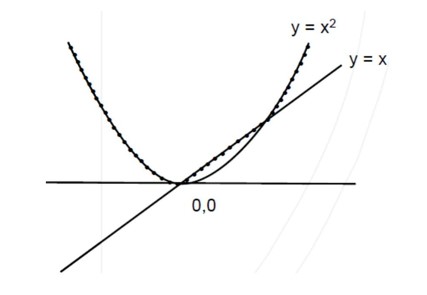Maths
Get insights from 6.5k questions on Maths, answered by students, alumni, and experts. You may also ask and answer any question you like about Maths
Follow Ask QuestionQuestions
Discussions
Active Users
Followers
New answer posted
2 months agoContributor-Level 9
Equation of normal to the ellipse x²/a² + y²/b² = 1 at (x? , y? ) is a²x/x? - b²y/y? = a² - b².
At the point (ae, b²/a):
a²x/ (ae) - b²y/ (b²/a) = a² - b²
It passes through (0, -b).
a² (0)/ (ae) - b² (-b)/ (b²/a) = a² - b²
ab = a² - b²
Since b² = a² (1-e²), a²-b² = a²e².
ab = a²e²
a²b² = a? e?
a² (a² (1-e²) = a? e?
1 - e² = e?
e? + e² - 1 = 0
New answer posted
2 months agoContributor-Level 9
Let the first A.P. be a? , a? + d, a? + 2d.
a? = a? + 39d = -159
a? = a? + 99d = -399
Subtracting the equations, 60d = -240 ⇒ d = -4.
Substituting d back, a? + 39 (-4) = -159 ⇒ a? - 156 = -159 ⇒ a? = -3.
Now, for the second A.P. with first term b? and common difference D = d+2 = -2.
b? = a?
⇒ b? + 99D = a? + 69d
⇒ b? + 99 (-2) = -3 + 69 (-4)
⇒ b? - 198 = -3 - 276
⇒ b? = -279 + 198 = -81
New answer posted
2 months agoContributor-Level 9
Let A (α, 0,0), B (0, β, 0), C (0,0, γ), then the centroid is G (α/3, β/3, γ/3) = (1,1,2).
α = 3, β = 3, γ = 6
∴ Equation of plane is x/α + y/β + z/γ = 1
⇒ x/3 + y/3 + z/6 = 1
⇒ 2x + 2y + z = 6
∴ Required line passing through G (1,1,2) and normal to the plane is (x-1)/2 = (y-1)/2 = (z-2)/1.
New answer posted
2 months agoContributor-Level 9
A = [cosθ, sinθ], [-sinθ, cosθ]
A² = [cos2θ, sin2θ], [-sin2θ, cos2θ]
⇒ A? = [cos4θ, sin4θ], [-sin4θ, cos4θ]
B = [cos4θ, sin4θ], [-sin4θ, cos4θ] + [cosθ, sinθ], [-sinθ, cosθ]
= [cos4θ + cosθ, sin4θ + sinθ], [- (sin4θ + sinθ), cos4θ + cosθ]
det (B) = (cos4θ + cosθ)² + (sin4θ + sinθ)²
= (cos²4θ + sin²4θ) + (cos²θ + sin²θ) + 2 (cos4θcosθ + sin4θsinθ)
= 1 + 1 + 2cos (4θ - θ)
= 2 + 2cos3θ
Given 3θ = 3π/5
|B| = 2 + 2cos (3π/5)
= 2 + 2 (- (√5-1)/4) = 2 - (√5-1)/2 = (4-√5+1)/2 = (5-√5)/2 ∈ (1,2)
New answer posted
2 months agoContributor-Level 9
f' (c) = 1 + lnc = e/ (e-1)
lnc = e/ (e-1) - 1 = (e - (e-1)/ (e-1) = 1/ (e-1)
c = e^ (1/ (e-1)
New answer posted
2 months agoContributor-Level 9
Equation of line is x/3 + y/1 = 1
⇒ x + 3y - 3 = 0
The image (x? , y? ) of point (-1, -4) is given by:
(x? - (-1)/1 = (y? - (-4)/3 = -2 (1 (-1) + 3 (-4) - 3) / (1² + 3²)
(x? + 1)/1 = (y? + 4)/3 = -2 (-1 - 12 - 3)/10 = -2 (-16)/10 = 16/5
x? + 1 = 16/5 ⇒ x? = 11/5
(y? + 4)/3 = 16/5 ⇒ y? + 4 = 48/5 ⇒ y? = 28/5
New answer posted
2 months agoContributor-Level 9
y = (2/π x - 1)cosec x
dy/dx = (2/π)cosec x - (2/π x - 1)cosec x cot x
⇒ dy/dx + (2/π x - 1)cosec x cot x = 2/π cosec x
⇒ dy/dx + ycot x = 2/π cosec x
This is a linear differential equation. The integrating factor P (x) is the coefficient of y.
⇒ P (x) = cot x
New answer posted
2 months agoContributor-Level 9
Applying Rolle's theorem in for function f (x), there exists c such that f' (c) = 0, c ∈ (0,1).
Again applying Rolle's theorem in [0, c] for function f' (x), there exists c? such that f' (c? ) = 0, c? ∈ (0, c).
Option A is correct.
New answer posted
2 months agoContributor-Level 9
Given equation is 2x (2x + 1) = 1 ⇒ 4x² + 2x - 1 = 0. Roots of the equation are α and β.
∴ α + β = -2/4 = -1/2 ⇒ β = -1/2 - α
and
4α² + 2α - 1 = 0 ⇒ α² = (1-2α)/4 = 1/4 - α/2
Now
α = 1/2 - 2α²
Substituting into the expression for β:
β = -1/2 - (1/2 - 2α²) = -1 + 2α²
Taking an Exam? Selecting a College?
Get authentic answers from experts, students and alumni that you won't find anywhere else
Sign Up on ShikshaOn Shiksha, get access to
- 65k Colleges
- 1.2k Exams
- 679k Reviews
- 1800k Answers

